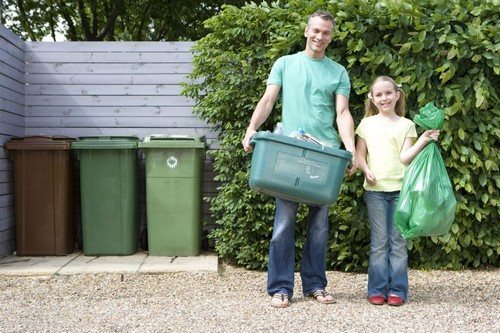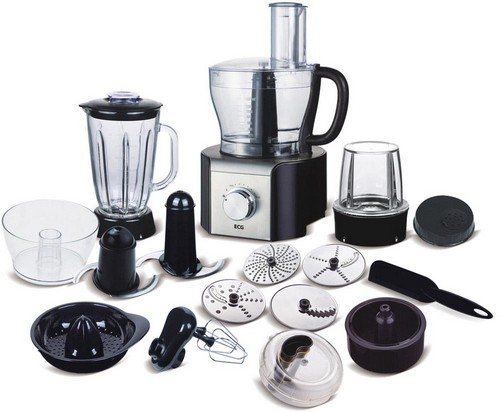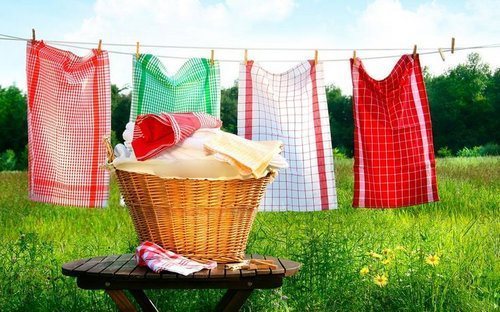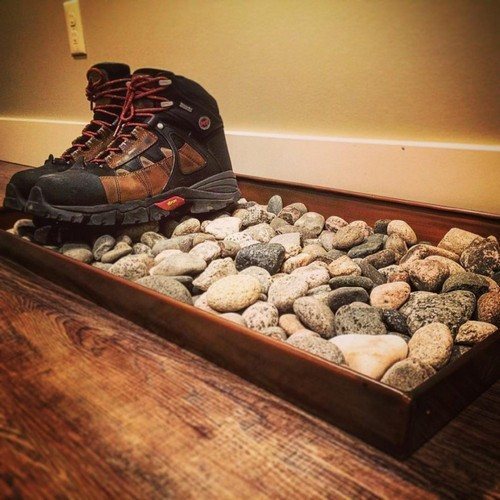Each person annually produces 200-400 kg of waste. Organizing waste separation in the kitchen is the first step to complete recycling of raw materials and to the maximum reduction in the amount of recycled materials.
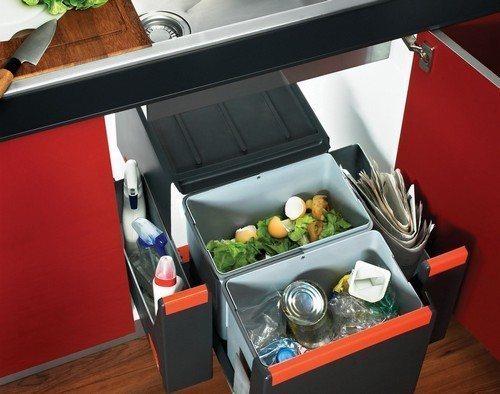
Based on the fact that household waste contains up to 70% organic matter, it is possible to find more progressive methods of processing, other than environmentally harmful incineration, burial or storage. This allows you to prevent the release of toxic elements into the environment (1.5 g from every kg of scrap). Heavy metals lead to mutations and deformities, which is why the isolation and recycling of such substances is so important for humanity. In addition, carcinogenic metals are valuable raw materials for electrical engineering.

The ratio of household waste is as follows:
- food waste (up to 40%);
- paper products (up to 30%);
- glass products (up to 8%);
- fabrics (up to 7%);
- metal products (up to 4%);
- plastic (up to 5%);
- other (wood, bones, leather, stones, rubber, etc. – up to 6%).
In autumn, the amount of organic matter reaches 55%, which makes it possible to launch year-round composting in the private sector and develop organic farming.
Given the rate of decomposition, each person leaves behind mountains, seas of sewage that will affect the entire ecosystem for thousands of years. Paper will decay in 10 years, scrap metal will break down after 100 years, broken glass will break down after a few hundred years, and plastic is scary to think about.

World experience
In many countries of the world (Germany, Italy, USA, Czech Republic, Japan, Switzerland and others), at the legislative level, citizens are forced to dispose of household waste. This makes processing cheaper and faster, and minimizes environmental damage. Failure to comply with this law provides for a system of fines.
They divided it interestingly in Japan - large-sized waste, recycled and burned, non-combustible. The waste bags are transparent to facilitate control by special services. Incorrectly divided waste is returned to the owner (plus a fine).
Residents have been taking out and disposing of construction waste in a separate category for a long time. It has already become customary to hand over mercury-containing lamps, lampshades and batteries to special collection points.
Kitchen, home - the first step for sorting waste
For this purpose, all tanks and containers have their own color marking, depending on the type of raw material. But it all starts in the kitchen, where each housewife decides for herself how exactly the waste division should be organized, depending on the size of the room and what the family regularly throws away.
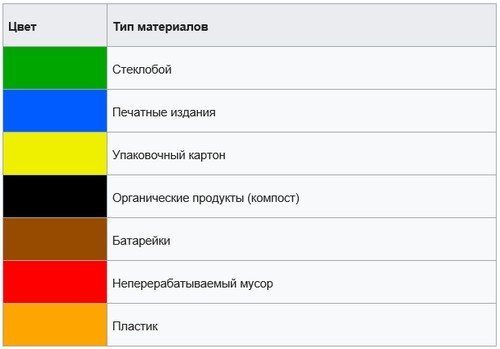
Sorting methods:
- installing multi-colored trash cans for each type of waste in the kitchen;
- division of residues into recyclable and non-recyclable, and on the street or in the basement near common containers there is a more detailed division;
- installing a grinder in the sink drain for food waste, the rest is divided by type, according to city rules;
- collecting everything in a single tank.
It will no longer be possible to remain on the sidelines. As soon as a city launches a separate waste collection system, all residents are required to comply with it. Waste is divided according to the capacity and type of plant.In many small towns, they began to divide sewage into only 2 groups: plastic and just garbage.
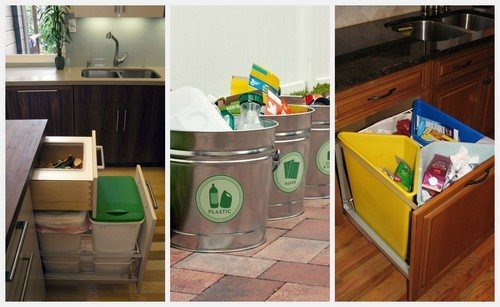
Household waste is divided into the following groups:
- Organic. In the private sector, such sewage can be stored in a special tank or pit, so that after rotting and fermentation, compost is obtained - a natural fertilizer and mixture for planting.
- Plastic and polymers. One of the worst disasters of our time. The decomposition period of bottles, bags, and boxes is more than 1000 years; because of it, millions of animals around the world die, unable to escape from deadly traps in the form of skeins of plastic fibers or by eating bright pieces of plastic. But most of these residues can be reused into bowls, furniture, and bottles. And non-recyclable plastic is crushed and pressed into floor tiles, paving, and building blocks.
- Paper waste. Despite the fact that this type of raw material is environmentally friendly and safe, to produce paper it is necessary to cut down hectares of forest, pollute tons of water, use aggressive chemicals for dissolution, bleaching, and spend a lot of fuel. But paper is recycled up to 7 times; every ton of waste paper collected will save 15 huge trees. The paper wrinkles easily, taking up little space.
- Metal. One of the most frequently recycled materials. Recycled metal is much cheaper than metal made from ore. This is especially true for aluminum. 70 collected drinks cans yield enough silver metal for a new bike. Foil and cans are well pressed, taking up little space.
- Glass. Some types of containers are accepted for reuse, and all glass waste can be recycled an infinite number of times.

It is optimal to divide household waste as accepted by the city service or as recommended by waste collection points. Yes, many residents have already begun to rent out everything for money (glass, plastic, paper, iron).
Fight from the first minute
Even in the tiniest kitchen, instead of one large bucket, you can put a sectional block - it contains 3-5 small containers labeled for different types of sewage. Compact containers fit well under the sink, although the trend has been changing lately. Such systems are attached to the sink door, placed in drawers of the kitchen corner, and fixed under the countertop. There is no need to open the sink door; just lift the countertop to get into the waste collection compartment.
For those who don’t have a lot of waste, stylish eco-bags on the wall are a good option. They are inexpensive, colorful and lightweight. Metal, paper, glass and plastic will be stored in bags, and wet organic residues in an airtight container.
6 tips for rational organization of kitchen waste:
- Installation of separate labeled containers for different waste.
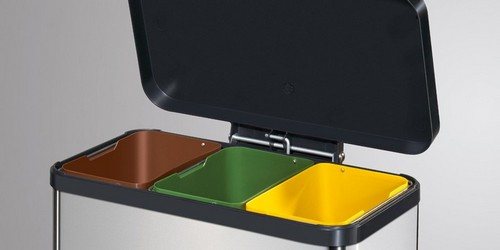
- Using an organic food chopper.
- Replacing paper and plastic bags with reusable containers and bags, biodegradable bags.
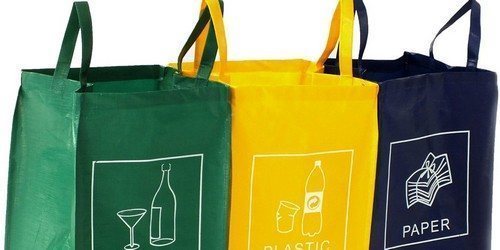
- Returning batteries to collection centers, which are located in all large supermarkets and tiny establishments.
- Selection of products in recyclable plastic (with a triangular arrow icon on the bottom of the package).
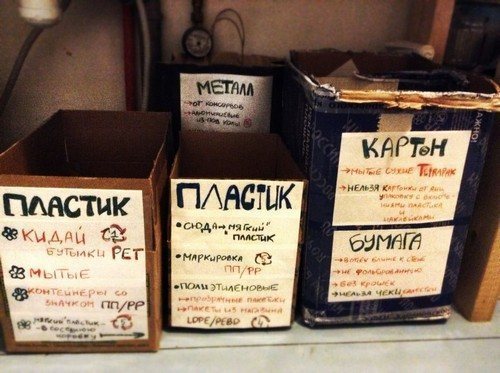
- Delivery of sorted waste to collection points (free or paid).
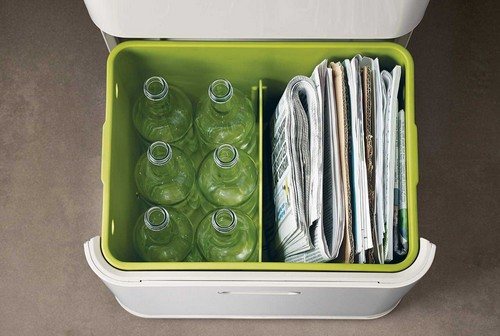
You should use compostable garbage bags, otherwise things that could rot in a couple of months (leaves, peels of vegetables and fruits) will be stored airtight until the film breaks or decomposes.
Options for selecting waste containers
Before purchasing, you should consider what type of garbage predominates, the volume per day, the location of the container, the size of the niche and the style of the kitchen interior.
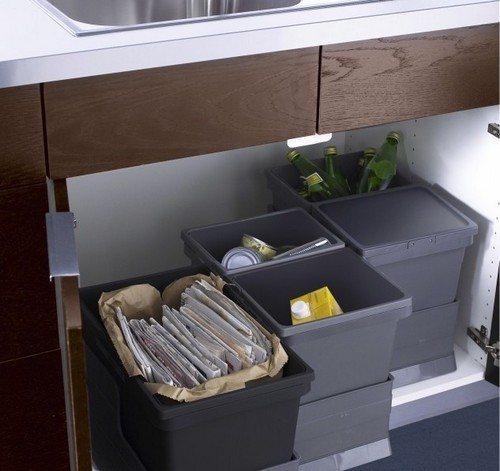
System selection criteria:
- easy to put in the container, can be opened without hands (touch, foot pedal, elbow pressure, pressure on the lid);
- Garbage bags are easy and quick to change;
- safe - there are no sharp corners, there is protection against accidental extension, the material is not fragile;
- environmentally friendly - non-toxic, made from degradable, recyclable or recycled materials;
- silent opening mechanism, plus a sealed lid;
- easy to clean, replacement parts are available;
- additional functions (odor absorption, filling sensor, pressing system).
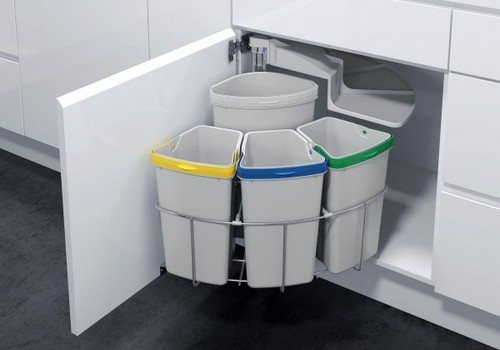
There are inexpensive plastic models or more solid chrome ones. You can put a large tank or stylish wooden boxes outside the cabinet, but then they should decorate the room. There are wall-mounted models that save space or grids for bottles, paper and plastic.

Each person contributes to the pollution of the Earth, therefore, everyone has a responsibility to do everything possible to reduce the harm and leave the planet viable for future generations. It’s not that difficult to do; you can start right today, at home.


